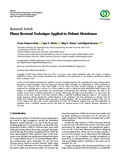Phase reversal technique applied to fishnet metalenses

Fecha
2018Versión
Acceso abierto / Sarbide irekia
Tipo
Artículo / Artikulua
Versión
Versión publicada / Argitaratu den bertsioa
Impacto
|
|
10.1155/2018/9461858
Resumen
In this work, the fishnet metamaterial is applied to several converging metalenses by combining the zoning, reference phase, and phase reversal techniques. First, the zoning and reference phase techniques are implemented in several metalenses at 55 GHz ( λ 0 = 5.45 m m ) with a short focal length of 1.5 λ 0 . Then, the phase reversal technique is applied to these metalenses by switching from a co ...
[++]
In this work, the fishnet metamaterial is applied to several converging metalenses by combining the zoning, reference phase, and phase reversal techniques. First, the zoning and reference phase techniques are implemented in several metalenses at 55 GHz ( λ 0 = 5.45 m m ) with a short focal length of 1.5 λ 0 . Then, the phase reversal technique is applied to these metalenses by switching from a concave to a convex profile in order to change the phase distribution inside of them. The designs are evaluated both numerically and experimentally demonstrating that chromatic dispersion (the shift of the position of the focus at different frequencies) is reduced when using the phase-reversed profiles. It is shown how the position of the focus remains at the same location within a relatively broadband frequency range of ~4% around the design frequency without affecting the overall behaviour of the metalenses. The best performance is achieved with the design that combines both reference phase and phase reversal techniques, with an experimental position of the focus of 1.75 λ 0 , reduced side lobes, and a power enhancement of 6.5 dB. The metalenses designed here may find applications in situations where a wideband response and low side lobes are required because of the reduced chromatic aberrations of the focus. [--]
Materias
Fishnet metalenses,
Phase reversal techniques
Editor
Hindawi
Publicado en
International of Antennas and Propagation, Volume 2018, Article ID 9461858, 8 pages
Departamento
Universidad Pública de Navarra. Departamento de Ingeniería Eléctrica y Electrónica /
Nafarroako Unibertsitate Publikoa. Ingeniaritza Elektrikoa eta Elektronikoa Saila /
Universidad Pública de Navarra/Nafarroako Unibertsitate Publikoa. Institute of Smart Cities - ISC
Versión del editor
Entidades Financiadoras
This work was partially supported by the Spanish Ministerio de Economía y Competitividad with European Union Fondo Europeo de Desarrollo Regional (FEDER) funds (TEC2014-51902-C2-2-R). Victor Pacheco-Peña is supported by Newcastle University (Newcastle University Research Fellow). Igor V. Minin and Oleg V. Minin were partially supported by the Mendeleev scientific fund of Tomsk State University.






